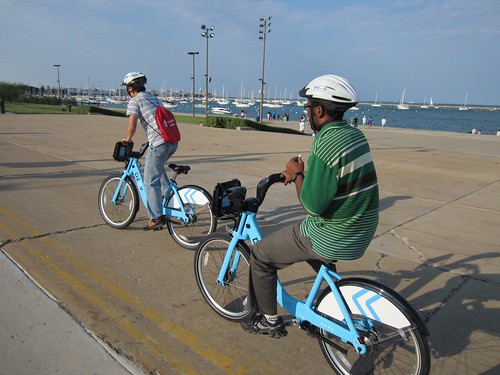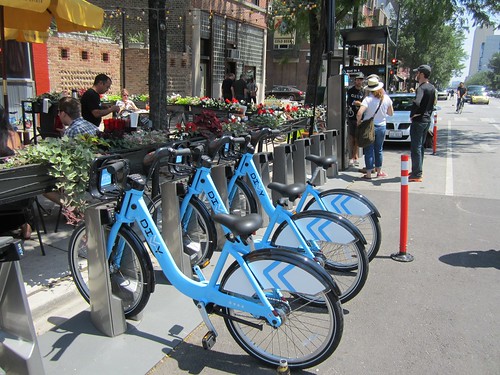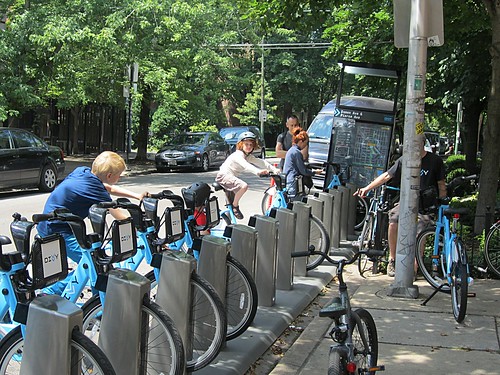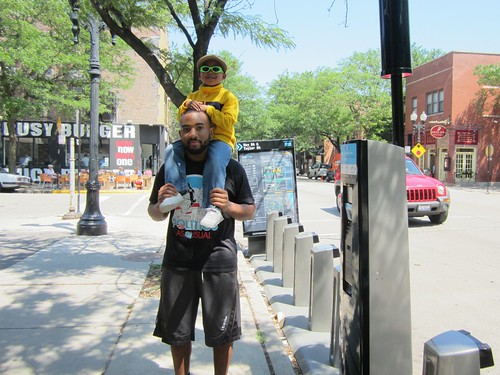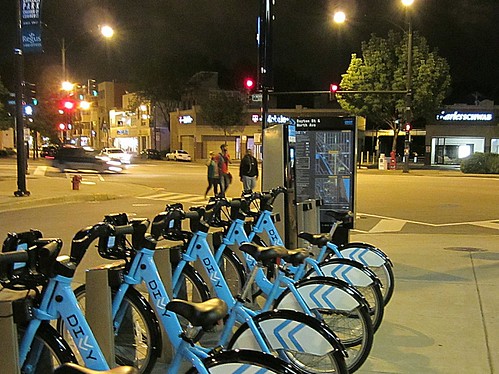In a hurry? Read a shorter version of this piece at Grist.org, an environmental news website.
To hear the Chicago Tribune tell it, people who used the Divvy bike-share system on its first day of operations last Friday experienced nothing but headaches. But on Sunday I rode a Divvy to and attempted to dock at all 68 of the existing stations and witnessed only a few glitches. For the most part, these seemed like minor speed bumps as the bike-share staffers and users get accustomed to this brand-new infrastructure. I also spoke to plenty of satisfied customers along the way.
The system, funded with $27.5 million in federal and local grants, is owned by the city of Chicago and operated by Alta Bike Share, Inc., which also runs public bike programs in Washington, D.C., Boston, Chattanooga and New York City. NYC’s Citi Bike program has seen more than its fair share of bugs, attributed to an Alta subcontractor switching software developers, but the system has still been wildly popular, with more than more than 50,000 annual memberships sold and 500,000 trips taken to-date. Problems with docking station power failures, common in the first two weeks, have largely subsided.
Chicago’s system will eventually include 4,000 bikes, clunky-but-comfy cruisers painted the powder-blue shade of the Chicago flag’s stripes, at 400 docking stations. The system launched Friday with 700 bikes at 61 stations, located within a roughly three-mile radius of the center of town. It will expand to 750 cycles at 75 stations by the end of this week, 3,000 bikes and 300 stations by the end of August, with the remaining 1,000 bikes and 100 stations installed next spring.
A $7 daily pass or $75 annual membership entitles users to an unlimited number of half-hour trips. To encourage turnaround of the bikes, a $2 late fee applies for the next 30 minutes, with charges rising steeply for subsequent half hours. As of today, more than 1,700 Chicago residents have bought memberships. 4,123 Divvy trips were taken from Friday morning to Sunday night, with 3,225 made by members and 898 made by people who bought 24-hour passes, according to the Chicago Department of Transportation.
Those numbers represent a modest success, but the Tribune article published last Friday evening, “Opening day woes greet Divvy bike sharing roll-out,” paints the first day as a dismal failure. Reporter Jon Hilkevitch previously published a hatchet piece characterizing the late fines and $1,200 replacement fee for lost or stolen bikes as onerous burdens, even though these policies are typical of successful bike-share programs in other cities.
For Friday’s article he also chose to accentuate the negative, quoting several customers who complained that they’d had problems with the system and zero who said they enjoyed using it. The complaints included stations that had no available docking capacity, forcing users to park at a nearby station; one downtown station that wasn’t working at all; inaccurate information about the quantity of bikes at stations from the CycleFinder app; and individual docks that wouldn’t accept bikes. “Chicago’s federally funded Divvy bicycle-sharing program rolled out on Friday, and the shared experience some customers came away with was frustration,” Hilkevitch wrote.
The one sympathetic quote from a Divvy user was, by an odd coincidence, from my high school friend Greg Baldi, visiting from out of town, who was unable to park at the malfunctioning station at State and Kinzie on his way to meet me for lunch. Baldi later told me, unprompted, that Hilkevitch seemed to be pushing him for a negative quote. “It’s frustrating, but this is the first day so they will have to work out the bugs,’’ Baldi told Hilkevitch, so the reporter described him as “forgiving” and an “avid cyclist."
While it’s important for Alta to make sure that malfunctioning stations don’t shake user confidence and that the info on the app is accurate, some of these issues are due to the learning curve. The experiences of other cities suggest it will take a couple of days for bike-share employees to learn usage patterns so that they can “rebalance” the bikes, using vans to relocate cycles from at-capacity stations to depleted ones. It certainly didn't help rebalancing efforts that much of the Loop was shut down Friday morning for the Blackhawks' victory parade. I also suspect that some of the customers who griped that docks weren’t working simply didn’t realize that you really need to slam the bikes into the docks in order to secure them.
On my epic, 12-hour, roughly 40-mile “Tour de Divvy” yesterday I encountered few negative reactions to the bike-share system, and those were mostly from folks who were unclear on the concept. Once I explained that the program is intended for short trips and errands from station-to-station, not long cruises on the lakefront, they usually concluded that Divvy might be useful.
One exception was a woman I encountered around noon on my first stop to pick up a bike at a docking station near the Blue Line in the trendy Wicker Park neighborhood. She was upset because the city hadn’t yet installed a station at Humboldt Park, which she wanted to visit with her kids, and she’d misunderstood the information a customer assistant gave her the previous day – she thought you could keep a bike for as long as you want for no extra charge as long as you don’t dock it for more than a half hour at a time.
However, the vast majority of Divvy users I encountered Sunday seemed generally pleased with the service. Wes Rizal, a member who was docking his bike in the River West neighborhood, said he’d driven downtown that morning with friends and used bike-share to get home. “I could have walked or taken the train, but I’m taking advantage of the fact that I can access a bike that isn’t my own,” he said. He has noticed that the CycleFinder app is not completely accurate. “It sometimes shows zero bikes at a station when there actually are bikes. The more of these bugs we get ironed out, the better it will be for all of us.”
When I encountered Hannah Gunning and her brother Kaz at a West Loop station, they were picking up bikes to ride to a commuter rail station to visit their dad in the ‘burbs. “I own a bike but I decided to give this a try,” Hannah said. “Why not? I lived in France for a while and used the Vélib' system all the time. There were stations everywhere there, so it was super-convenient.”
Leland Bonner was checking out a station in Little Italy while carrying his young son Jayden on his shoulders. “It looks pretty convenient and it’s very affordable, so I think we might have to give this a try,” Leland said. “Do you think these bikes are cool?” he asked Jayden. “I want to ride one,” the boy answered.
When I pedaled to the 18th Street business strip in Pilsen, I saw Rito Negrete perusing a station across the street from Irv’s Bike Shop. “I was driving by and I saw this, so I double parked to check it out,” he said. “I’m just visiting my old neighborhood but I’ve still got a lot of family here and I want to share this info with them. I think a lot of people here are going to like this. I’d like to check out one these bikes and ride to the lake some time.”
In the South Loop I met Priya Suriya and Paul Meinshausen, who were docking her Divvy (he was on his own fixie) across the street from a Trader Joe’s, having already done some shopping by bike at a Target store. Since they just moved here from Boston, they were already comfortable using the Alta-run Hubway system. They’d been enjoying running errands on this gorgeous afternoon, but reported that some of the stations at the most popular destinations, like Millennium Park, tend to fill to capacity. “It seems like they haven’t quite gotten the hang of rebalancing yet,” Suriya said.
When I got to the sole lakefront station, at Monroe Street, I saw this issue for myself. It was obvious that the small station here didn’t have enough docks to accommodate all the people who wanted to park their Divvy and stroll along the shore. Also, one of the docks was physically broken – a metal pin in the locking apparatus was not engaging, making it impossible to secure a bike.
As she waited in line to access the kiosk touch screen to request an additional 15 minutes of time, Haruko Yamauchi, in town for a library conference, told me that, despite this inconvenience, she’d enjoyed her ride up the lakefront from the McCormick Place convention center. “The bikes are heavy and the fat tires make them kind of slow, but they’re a lot of fun to ride,” she said.
Up at the Oak Street Beach station I talked with Vincent Smith and his two friends, who’d been “dock surfing” all afternoon, just as I had – it’s an open secret that you can keep a bike as long as you like without late fees, as long as you check it into a station every half hour. They’d been at the Pride Parade in Boystown and had slowly been working their way downtown by Divvy. “Once you get used to the system, it’s really easy to get around,” Smith said.
I myself was having a fun day of cruising from station-to-station, but it was well after dark as I knocked out stops in Old Town and Lincoln Park, my legs aching from many miles of powering the Clydesdale of a bike, and I started developing a blister on the thumb of my gear-shift hand. At a station near the Brown Line’s Diversey stop I encounter the most serious problem of the day. None of the docks allowed me to securely park my ride – there seemed to be a Citi Bike-style power failure going on. I called the help line and the customer service rep promised to send someone to fix the problem immediately.
After I checked in at the last two stations, around midnight, I made my way back to Wicker Park to dock my bike once more and catch the Blue Line home to Logan Square, which doesn’t have Divvy yet. As I pedaled, I crunched the numbers. Out of the 68 stations in the system, there were only two where I had been unable to park, a respectable number for a system that had only been running for three days. While it’s clear the bike-share system still has a few kinks to work out, using it all afternoon and evening was far from a frustrating experience. Instead, Divvy allowed me to visit almost every sector of the central city in one day, highlighting its potential to be Chicago's next great transportation system.
View photos from the early days of Divvy, including just about every station in the system as of Sunday night.
